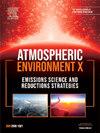Observation-based investigation reveals major sources of heavy metals associated with fine particulate matter (PM2.5) in an East Asian urban area
IF 3.4
Q2 ENVIRONMENTAL SCIENCES
引用次数: 0
Abstract
Exposure to elevated levels of fine particulate matter (PM2.5) has been a major public health concern for decades. However, the specific sources of air toxics associated with PM2.5 remain unclear. In this study, we investigate PM2.5 pollution in Taichung, Taiwan—a representative East Asian metropolitan area— during March and November of 2021–2023 using an advanced two-stage positive matrix factorization (PMFxPMF) approach. This method enables detailed source apportionment of both bulk PM2.5 and PM2.5-bound heavy metals. Our analysis reveals that, during the East Asian winter monsoon seasons, regional transboundary pollution contributed 38 % to the PM2.5 load, while local sources—such as carbonaceous aerosols, industrial processes, ammonium nitrate/chloride, and transformed sea spray—contributed between 9 % and 20 %. Furthermore, the formation of nitrate was the primary driver of air quality deterioration. Heavy metals constituted 1.2 %–1.5 % of PM2.5 mass (0.24–0.32 μg m−3). By incorporating heavy metal fingerprints from two major local sources—coal-fired power plants and steel sintering facilities—as constraints in our PMF analysis, we reveal that ambient non-Fe heavy metals were mainly associated with suspended dust (34 %), implying significant health risk of dust exposure. Besides, vehicular pollution accounted for 14 % of non-Fe heavy metals, highlighting the need for a stronger control on non-exhaust vehicular emissions. Substantial contributions arose from coal combustion (9 %), steel sintering (5 %) and various industrial sources (22 %). Our results underscore the importance of accelerating the timeline for coal phaseout, and warrant a further investigation on the emissions of heavy metals from industrial activities.

基于观测的调查揭示了东亚城市地区细颗粒物(PM2.5)相关重金属的主要来源
几十年来,暴露于高浓度的细颗粒物(PM2.5)一直是一个主要的公共卫生问题。然而,与PM2.5相关的空气有毒物质的具体来源仍不清楚。本研究采用先进的两阶段正矩阵分解(PMFxPMF)方法,对2021-2023年3月和11月具有代表性的东亚大都市台湾台中地区的PM2.5污染进行了研究。这种方法可以详细地分析PM2.5和PM2.5结合重金属的来源。我们的分析表明,在东亚冬季季风季节,区域跨界污染对PM2.5负荷的贡献为38% %,而本地来源(如碳质气溶胶、工业过程、硝酸铵/氯化铵和转化的海雾)的贡献在9% %至20% %之间。此外,硝酸盐的形成是空气质量恶化的主要驱动因素。重金属占PM2.5质量的1.2 % ~ 1.5 %(0.24 ~ 0.32 μg m−3)。通过将当地两个主要来源(燃煤电厂和钢铁烧结设施)的重金属指纹作为PMF分析的约束条件,我们发现环境中的非铁重金属主要与悬浮粉尘有关(34% %),这意味着粉尘暴露的重大健康风险。此外,机动车污染占非铁重金属的14% %,凸显了加强对机动车非尾气排放控制的必要性。煤炭燃烧(9 %)、钢铁烧结(5 %)和各种工业来源(22 %)都是主要贡献。我们的研究结果强调了加快煤炭淘汰时间表的重要性,并保证了对工业活动中重金属排放的进一步调查。
本文章由计算机程序翻译,如有差异,请以英文原文为准。
求助全文
约1分钟内获得全文
求助全文
来源期刊

Atmospheric Environment: X
Environmental Science-Environmental Science (all)
CiteScore
8.00
自引率
0.00%
发文量
47
审稿时长
12 weeks
 求助内容:
求助内容: 应助结果提醒方式:
应助结果提醒方式:


